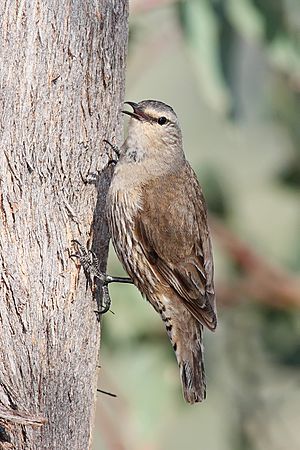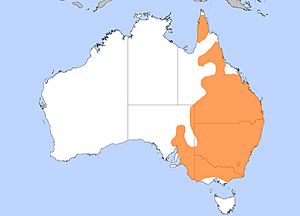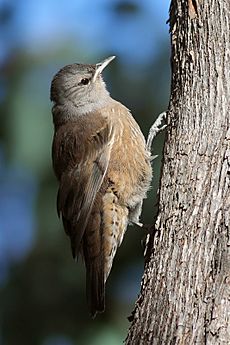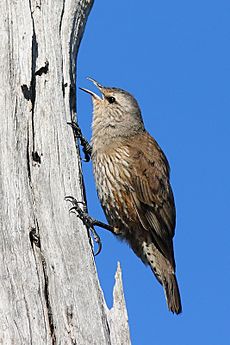Brown treecreeper facts for kids
Quick facts for kids Brown treecreeper |
|
|---|---|
 |
|
| Conservation status | |
| Scientific classification | |
| Genus: |
Climacteris
|
| Species: |
picumnus
|
 |
|
| Range in orange | |
The brown treecreeper (Climacteris picumnus) is the biggest type of Australasian treecreeper. This bird lives only in eastern Australia. You can find it from Cape York Peninsula in Queensland, all the way through New South Wales and Victoria, down to Port Augusta and the Flinders Ranges in South Australia.
Even though it's still found in many places, its numbers have gone down in some areas, like Adelaide and Cape York. Brown treecreepers live in many different places, from coastal forests to dry mallee shrublands. They often prefer woodlands with lots of eucalypt trees, especially where there isn't a thick layer of bushes underneath.
Contents
Discovering the Brown Treecreeper
Scientists Coenraad Jacob Temminck and Meiffren Laugier de Chartrouse first described the brown treecreeper in 1824. It still has the same name today. It is one of six types of treecreepers found in Australia.
This bird is most closely related to the rufous treecreeper and the black-tailed treecreeper. All three live in similar open woodlands. Male and female birds of these types have different markings on their chest or throat. Males have black markings, while females have reddish ones.
Different Types of Brown Treecreepers
There are three main types, or subspecies, of the brown treecreeper:
- The picumnus subspecies lives across a wide area, from Victoria through New South Wales to Queensland.
- The victoriae subspecies is found along the Great Dividing Range. It mixes with the picumnus type in some areas.
- The melanotus subspecies lives from Cape York Peninsula south to Cooktown. This one is sometimes called the black treecreeper because it has darker, sooty brown feathers. It is also a bit smaller than the other types.
People sometimes call the brown treecreeper a "woodpecker." This is because it climbs up tree trunks in a spiral, just like a woodpecker.
How We Protect Brown Treecreepers
The IUCN (a big group that checks on nature) says the brown treecreeper is of "least concern." This means it's not currently in danger of disappearing.
However, one type, the victoriae subspecies, is listed as "Vulnerable" in New South Wales. In Victoria, it's considered "Near-threatened." This means these specific groups need more protection to keep their numbers healthy.
What Does a Brown Treecreeper Look Like?
Adult brown treecreepers are about 16.5 centimeters (6.5 inches) long. Their wings can spread about 26 centimeters (10 inches) wide. They usually weigh around 31.5 grams (about the same as a few coins).
Their feathers are light grey-brown on top, with a light grey face and neck. Their head is darker grey, and they have dark patches covering their ears. Adults have a clear, pale stripe above their eye. Young birds have a grey, less clear stripe.
The throat of the bird is creamy white, and its chest is pale brown. The lower chest has thin black-grey and white stripes. When they fly, you can see a dark bar on their wings.
Spotting the Difference Between Males and Females
Male and female brown treecreepers look a bit different.
- Males have black and white stripes on their upper chest.
- Females have reddish and white stripes instead.
Young birds have darker feathers on their neck and head than adult males.
What Does It Sound Like?
The call of the brown treecreeper sounds like "spink spink."
Living Together and Finding Food
Brown treecreepers are social birds. They live in groups with a complex social structure. They have their own territory, which sometimes overlaps with other groups of treecreepers. You usually see them in pairs or small groups of up to eight birds. They often allow other groups of their kind to enter their territory.
At night, brown treecreepers roost alone. During the day, they look for food on the ground and on trees. They often feed in small groups or pairs. Their main diet includes ants, beetles, and insect larvae.
They sometimes eat nectar from flowers. But mostly, they search for food in cracks and hollows of trees. They hop along logs or spiral up trees with rough bark. If they live in a dry area, they spend more time looking for food on the ground.
Building a Nest
Brown treecreepers work together to raise their young. They usually form a pair that stays together for a long time. Both male and female birds can breed when they are one year old. Females usually find a mate within two years, while males often find a breeding spot after three years.
The breeding season runs from July to February. Most eggs are laid from September to late October. Only the female bird sits on the eggs to keep them warm.
Where They Build Nests
Nests are usually built inside a tree hollow under the tree canopy. They are often near the edge of another treecreeper group's territory. This helps them get extra help with feeding the young.
All members of the group help build the nest. It takes about one to two weeks to build. They use twigs, grass, leaves, bark, animal fur, and even human trash like aluminum foil. One bird was even seen collecting fur from a live possum. The female usually carries the heavier materials and might throw out things brought by other group members.
Raising Young Birds
The female usually lays three eggs, but sometimes two or four. The eggs are smooth, slightly shiny, and a bit pink or reddish-brown. They have red and purplish-red speckles. Each egg is about 22.6 by 17.9 millimeters in size.
Eggs are likely laid about 24 hours apart. If a nest fails, the female might lay new eggs. Females can raise two groups of chicks in one season, but they usually raise only one. Chicks hatch about 14 to 16 days after the eggs are laid. They have grey fuzz on their heads and backs.
Feeding the Chicks
For a few days after hatching, the male bird feeds the female. The female then feeds the young chicks, getting food from the male. All group members help remove waste from the nest, but males do it most often.
Helpers, usually young males related to the breeding male, help feed the chicks in their own territory. They also often help at nests in two or three other territories. Chicks are fed a variety of insects, mostly caterpillars. Adult birds avoid feeding ants to the young, probably because ants have a strong acid.
Helpers contribute just as much to feeding the young as the breeding pair. There are records of one helper bird helping at nests in five different territories! When helpers are present, nests are four times more likely to succeed. They also produce many more young birds.
Leaving the Nest and Moving On
Chicks leave the nest when they are between 21 and 26 days old. This usually happens over a few hours. At first, they can't fly very well. They roost in tree hollows for a day or two. Group members feed them until they can take care of themselves, about 30 to 40 days later.
About half of breeding groups successfully raise at least one young bird each season. Young birds get their adult feathers about two months after leaving the nest. Adult birds start losing their old feathers in November or February, and new ones grow by March or April.
Where Do They Go?
Young females usually leave their home territory after winter to find a place to breed. Males rarely leave their home territory. They often stay as helpers until they can take over a breeding spot. This can happen if they inherit part of their home territory. Females move further than males, sometimes up to 5 kilometers (3 miles), to find a new breeding territory.
Dangers to Brown Treecreepers
The brown treecreeper faces several threats.
- Land clearing destroys their habitat and breaks it into smaller pieces. This makes it harder for young birds to find new homes.
- Removing fallen timber and logs also hurts them. These are important places for them to find food.
- Competition with other species like the common starling is also a problem. Starlings compete for the same tree hollows that treecreepers use for nesting.
One type, the melanotus subspecies in Cape York Peninsula, has seen its numbers drop. This is thought to be because of more frequent and widespread fires. These fires destroy the fallen logs and tree trunks where these birds like to forage for food.
See also
 In Spanish: Corretroncos pardo para niños
In Spanish: Corretroncos pardo para niños




